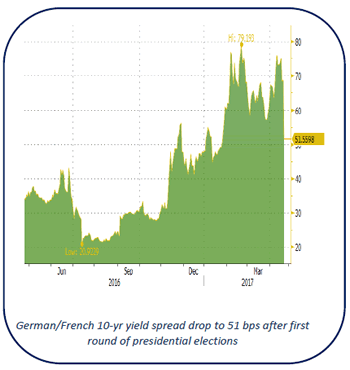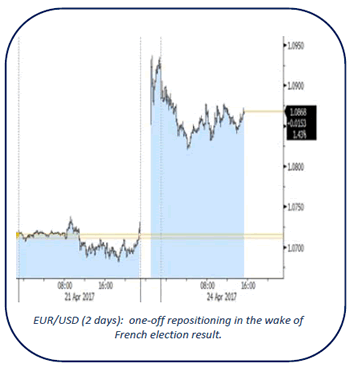Headlines
European equities gain 2% to 3% as markets welcome the second round French presidential run-off between Macron and Le Pen. The French CAC40 outperformed (+4.5%). US stock markets profit from risk-on sentiment, opening around 1% higher.
German business sentiment rose to the strongest level in almost six years. The IFO-indicator increased to 112.9 in April from a revised 112.4 in March while consensus expected a stabilization. A forward looking gauge of expectations fell to 105.2 from 105.7 though.
UK manufacturers were hit by a dip in orders this month suggesting the shine may be coming off a sector that has been given a boost from sterling weakness. The CBI’s latest health check of the sector reported a slight dip in total new orders in April to a balance of +4, lower than a forecast of +5 and declining from +8 in March.
Greece’s primary budget surplus – which measures the country’s public finances when excluding debt repayments – hit 4.2% last year, swinging dramatically from a deficit and far outperforming a creditor target of 0.5% for 2016.
Donald Trump has ratcheted up tensions in East Asia via hastily scheduled calls to the leaders of China and Japan, as fears simmer about a looming crisis over North Korea. The timing suggests Mr Trump is preparing a response in case Pyongyang conducts a new nuclear test, amid speculation such a move could come as early as Tuesday.
Rates
Macron-Le Pen run-off triggers relief rally
European markets opened relieved this morning as the first round of the French presidential elections produced a run-off between centrist Macron and extreme-right candidate Le Pen. Macron is expected to gain a landslide victory on May 7. Core bonds lost ground, the single currency profited, equities marched more than 3% higher and peripheral spreads narrowed significantly. Trading shifted into lower gear after the repositioning (no longer discounting Frexit risk) in the opening with a lot of sideways action. German IFO business climate improved more than expected, but the forward looking "expectations" component disappointed. Markets ignored the release.
At the time of writing, the German yield curve trades 9.9 bps (10-yr) to 12.1 bps (30-yr) higher. Technically, the German 10-yr yield bounced off key support and trades back in the 0.2%-0.5% sideways range. Changes on the US yield curve vary between +4 bps (30-yr) and +6.3 bps (2-yr). Both the 5-yr yield (1.8%) and the 10-yr yield (2.3%) regained lost support levels. Upcoming supply and Trump’s promise to unveil his tax reform plan in the second half of the week pushed affected US yields together with spill-over effects. On intra-EMU bond markets, 10-yr yield spread changes versus Germany narrowed 18 bps for France versus 11 bps for Belgium. Peripheral spreads declined by 14 bps to 30 bps. Italian BTP’s didn’t suffer from Friday’s rating downgrade by Fitch (BBB; stable) or upcoming supply (Thursday). Core spreads dropped 4 to 5 bps.
The Belgian debt agency tapped the on the run 7-yr OLO 79 (€0.9B 0.2% Oct2023) and 10-yr OLO 81 (€1.6B 0.8% Jun2027) for a combined €2.5B, the maximum of the amount on offer. The auction bid cover was solid at 1.59. The debt agency now completed 53% of this year’s OLO funding need (€35B).

Currencies
Euro jumps, but no follow-through gains
(European) markets succeeded a one-off risk-on repositioning after the marketfriendly outcome of the French presidential election. EUR/USD and USD/JPY started the session with good gains compared to Friday’s close. However, both cross rates almost immediately found a new ST equilibrium and held tight ranges for the remainder of the session. EUR/USD holds close to the 1.0850 pivot. USD/JPY is drifting sideways in the low 110 area.
Overnight, a pro-Europe risk-on trade started after the market-friendly outcome of the French presidential election. Equities, core yields and the euro jumped higher early in Asia. The safe haven yen was sold. However, except for Japan, most regional equities lost a big part of the early gains. China even showed substantial losses. EUR/USD jumped temporary north of 1.09, but returned to the 1.0865 area at the start in Europe. A similar reaction occurred in USD/JPY with the pair changing in hands in the low 110 area.
European investors evidently also adapted positions in the wake of the French election. German bond yields rose up to 10 bps and European equities jumped sharply higher with the CAC rising more than 4%. The FX market found some kind of short-term equilibrium after the initial uptick in EUR/USD and USD/JPY overnight. The interest rate differentials between the US and Europe narrowed a few bps at the start of trading, but the changes were modest (about 5 bps). EUR/USD settled in a tight range close to and mostly slightly above 1.0850. USD/JPY hovered sideways in the low 110 area. So, there was no follow-through price action on the overnight FX moves. The German IFO business confidence was slightly stronger than expected, but without impact on the major FX cross rates.
US markets joined the risk-on rebound from Europe, but the price swings in the dollar remained very limited. EUR/USD is trading in the 1.0865/70 area and USD/JPY is changing hands at around 110.20. At least for now, the election is no game-changer for trading in the major USD cross rates.

EUR/GBP off the recent lows on euro strength
Sterling trading was also mostly driven by the impact of the French election result on global markets. The euro jumped higher across the board. EUR/GBP filled offers north of 0.85 early in Asia and the 0.85 level was revisited at the start in Europe. The EUR/GBP rally stalled, as was the case for EUR/USD, and the pair settled in a relatively tight range in the upper half of the 0.84 big figure. The price swings in cable were very limited. The pair hovered around the 1.28 pivot, showing no real directional trend. The CBI total orders trends printed slightly softer than expected at 4 (from 8 on March). The report suggests a further softening of growth at the start of Q2, but the impact on sterling trading is limited. EUR/GBP is currently trading in the 0.8495/0.85 area. Cable drifted back south of 1.28 (currently 1.2785). There is still no clear story for sterling trading. However, key support around 0.83 looks safe for now thanks to the euro rally.














